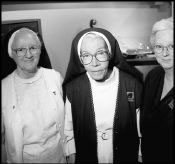ISLAND REVOLUTION: JAMAICAN RHYTHM FROM SKA TO REGGAE, 1951-1981
Experience Music Project, 770-2700, $19.95 9 a.m.-9 p.m. Sun.-Thurs., 9 a.m.-11 p.m. Fri.-Sat. opened June 8
REGGAE OCCUPIES A PLACE in the current musical Zeitgeist that’s either below barbershop quartet or hovering around the top with the rap-metal bands. It all depends on what you think of chart-topper Shaggy, and how closely you align him with the idiom that sprung from the streets of Kingston, Jamaica, and is today personified by Bob Marley.
Back in November 1982, however, reggae was infiltrating popular music in a number of unlikely ways, sneaking into British pop and American rock melodies, and paying off dividends to American soul stars who unwittingly had played a part in reggae’s development. At 13, I witnessed this firsthand when my dad toted me off for a family vacation in Jamaica. Our trip coincided with the one-year anniversary of Marley’s death—at 36 from cancer—and with a three-day celebration called the Jamaican World Music Festival. In a dusty, pebble-strewn Montego Bay field, a lineup of artists came together that symbolized reggae’s astonishing progression from the soundtrack of Kingston’s ghettoes to a key influence on Western pop. Though I was too young to fully appreciate it, I saw Bob’s widow Rita Marley with the Wailers, Peter Tosh, Gladys Knight and the Pips, the B-52s, Black Uhuru, Joe Jackson, the Clash, and the Grateful Dead, all sharing the stage in succession—and that was only the first night.
Now, older and more intimate with musical history, I see this event not so much as a celebration or remembrance, but as a culmination. Marley’s death, and Tosh’s assassination less than a decade later, robbed the island nation of its icons and siphoned away reggae’s role in popular music. The evolution of reggae, from the sound systems in Kingston to rock steady, ska, and dub, is no less enthralling, however; its cultural implications and musical manifestations shine as brightly as the sun on the beaches of Ocho Rios.
This is a pensive way of looking at reggae, which, after all, has become the feel-good stoner music of dorm rooms and frat bars. (Feelin’ irie, mon?) But it is the ambitious approach taken by Experience Music Project in its new exhibit, “Island Revolution: Jamaican Rhythm from Ska to Reggae.”
CURATOR DAVE ROSENCRANS’ eyes light up as he moves around the gallery, particularly when he comes to a section marked “Alpha Boys’ School.” The school for troubled boys has been a hotbed of musical activity for decades, thanks mostly to an artistically curious nun named Sister Mary Ignatius Davies. The 79-year-old Davies is one of the many Jamaicans who provided Rosencrans with the artifacts and stories that make up “Island Revolution”; she’s even lent her record collection to the museum.
During the course of three visits to Jamaica and a few side journeys, Rosencrans amassed 120 items, from dub legend King Tubby’s original studio mixing console, to Rastafarian drummer Count Ossie’s handmade percussion instruments, to a weathered box with hand-painted musical notes and stars— the speaker cabinet from one of Jamaica’s foremost sound system operators. That many American music fans don’t even know what a Jamaican sound system is was clearly a source of inspiration to Rosencrans. (A sound system’s basically a high-powered stereo from which DJs would blast the latest soul and R&B records from America, and later, songs by Jamaican artists.) Such thoroughness, and the integrity that inspires it, proved useful. How did he convince Jamaicans to entrust one-of-a-kind artifacts to a white visitor from Seattle for display in a distant museum? He recalls, “There seemed to be a moment when people would say, ‘This guy is going to tell the story right.'”
And Rosencrans does. Visitors enter the gallery and read about sound systems, then proceed to a brief history lesson on colonial Jamaica. Passing through an arch that symbolizes Jamaica’s 1962 independence from the British Commonwealth, the exhibit moves through more background—such as the Alpha Boys’ School and African roots music’s sway over Jamaica—then into the realm of the ’60s and ’70s ska and dub movements (including artifacts and information concerning Lee “Scratch” Perry), and onward into the early days of reggae. (EMP’s usual high-tech accoutrements, from the Museum Exhibit Guides and kiosks to film presentations, figure prominently.)
Because “Island Revolution” only extends through 1981, EMP misses the opportunity to explain how an island the size of Connecticut went on to exert such a strong musical influence that the Rolling Stones, the Clash, the Police, and the Grateful Dead would embrace reggae, if not completely alter their established sounds because of it. Also absent is a connection between Lee “Scratch” Perry’s spacey dub excursions and the many young electronic and rock artists of today whose music derives in whole or part from the deep rhythmic jerks that Perry popularized. Rosencrans suggests that such things can be inferred, though, and he may be right.
A savvy music fan might consider “Island Revolution” an academic exercise rather than a mainstream museum exhibit. Marley is a minor figure here, popping up in old photos and on early 45s that point to his role without hitting people over the head with it the way collections like his top-selling Legend does. “He’s here at every portion of his career,” Rosencrans says of Marley. “I just don’t allow him to dominate.” Even better, Shaggy’s nowhere to be seen.







